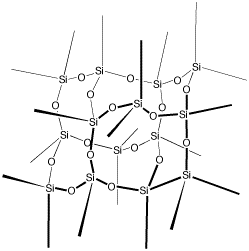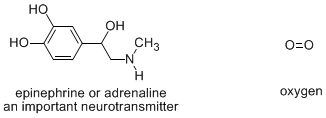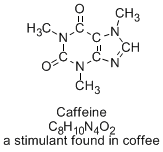
Figure IM1.1. A representative chunk of a non-molecular solid.
Structure & Reactivity in Chemistry
Introduction to Molecules
IM.1. Why do molecules matter?
Molecules aren't everything
To get a good idea of what a molecule is, let's first look at what a molecule isn't.
Not all things are composed of molecules. Many common rocks and minerals are composed mostly of silica. Silica is a non-molecular network solid with the approximate formula SiO2. Its structure keeps going on in all directions. The chunk of silica shown below shows just 14 silicon atoms, but a real chunk of silica could contain 14 thousand or 14 million silicon atoms, or just about any other number.
Figure IM1.1. A representative chunk of a non-molecular solid.
In contrast, a molecule is made from a particular number of atoms, and so it has a particular size. The atoms in silica are not collected into discrete units of a particular size; instead, they can be arranged in very large arrays of different sizes. A unit of silica could contain a million silicon atoms or a billion of them.
Molecules contain a specific combination of atoms in a specific ratio. That isn't exactly true in silica. There really are about twice as many oxygen atoms as silicon in silica and the atoms are arranged in a particular way, but the Si:O ratio can vary slightly, and there are also small amounts of hydrogen (but so small an amount that we ignore it in the formula).
Copper metal is also a non-molecular solid, with legions of copper atoms bonded together to form one united mass. The copper atoms are arranged in a particular way, and the metal has a very specific formula (Cu), but like silica, a unit of copper could contain a million copper atoms or a billion of them
Figure IM1.2. A representative chunk (or unit cell) of a metal..
Rocks and metals are non-living, inorganic materials. We are often interested in with chemicals used by biological systems. Those compounds are overwhelmingly molecular.
Origins and scope of inorganic and organic chemistry
Sometimes you will hear the terms "organic chemistry" and "inorganic chemistry", as in "I've got an inorganic chem lab today" or "I just did really well on my o-chem test". Sometimes high school or first year chemistry is called "inorganic", but that isn't really a good description. What do these terms really mean?
The realization during the European Renaissance that there is an entire chemistry unique to living things gave rise to the study of organic chemistry. Researchers working in medical schools labored to discover the active principles that could be found in herbal remedies and spices, which at that time formed an important part of the treatment of disease. The chemistry of the biological world seemed completely separate from that of the mineral world, and consequently organic chemistry developed as a separate discipline from inorganic chemistry.
Organic compounds are based on only a few elements from the upper part of the periodic table. The principle component of organic molecules is carbon. Carbon atoms are able to bond with each other to form bigger and bigger structures.
In addition, organic compounds frequently contain hydrogen, oxygen and nitrogen; phosphorus and sulfur are occasionally seen as well. With just these atoms, the major classes of structural biomolecules can be made (lipids, proteins and nucleic acids). Most small, biologically relevant molecules contain only this small group of atoms, including hormones, neurotransmitters and compounds involved in chemical ecology.
Figure IM1.3. The "organic" part of the periodic table.
Some marine organisms produce halogenated compounds containing bromine, chlorine or iodine. These compounds don't perform an obvious function in these organisms. Many halogenated organic compounds are toxic, and so it is possible that marine organisms use these compounds as a self-defense measure; chemical warfare is not unheard of in nature.
In addition, halogenated compounds are sometimes useful in carrying out organic reactions in the laboratory or in industry.
Occasionally other elements play extremely important roles in biological molecules; for example, vitamin B12 contains a cobalt atom bonded to a carbon, and plays an important role as a regulatory agent. However, by and large, organic and biological compounds contain very few elements: C, H, O, N, occasionally S and P, and sometimes halogens.
Applications of organic chemistry are wide-ranging. An obvious practical area is the pharmaceutical industry, because small organic molecules are frequently biologically active. However, one of the earliest industrial applications of organic chemistry was the dyestuff and paint industry, because many pigments can be made from organic compounds. It has been argued that the development of this industry in Germany in the 1800's was closely connected to the rise of that country as a major industrial power. Today, Germany is still an important center for research and development in chemistry. One of the biggest applications is polymer chemistry, which involves very large molecules or "macromolecules" that are useful as plastics and other materials. Most organic polymers are derived from petroleum, but a growing fraction of them come from agricultural materials such as corn and soybeans.
Inorganic chemistry is just the rest of chemistry. It is the part that is not principally based on carbon. It turns out that there is a lot of important inorganic chemistry in biology, as well. Frequently, metal ions play crucial roles in There are important applications of inorganic chemistry, too. Many important materials are inorganic, such as ceramics and solid-state materials used as conductors and semiconductors. Many industrial catalytic processes, such as refining petroleum or making detergent, require catalysis by transition metals. Metals themselves are important in society, and often inorganic chemistry is required to extract metals out of natural ores.
In Living Systems, the Focus is Often on Molecules
Biological structures like DNA, proteins and cells all depend on molecules. A strand of DNA is a very long molecule, and so is a protein. Cells are complicated, organized structures built up from huge numbers of smaller molecules.
There are lots of important small molecules in biology, too. Neurotransmitters like epinephrine are pretty simple molecules, but without them our nervous system couldn't work. Oxygen, containing just two oxygen atoms, is a very simple molecule, and it is certainly essential to living things.

Figure IM1.4. Two examples of molecules.
Molecules aren't only found in biology. Sulfur is a molecule that is found naturally in the earth. It contains a group of sulfur atoms connected in a ring, like a daisy chain. Carbon nanotubes and fullerenes are carbon-containing molecules that can be found in meteorites as well as some kinds of steel.

Figure IM1.5. Some non-biological molecules.
In general, this is a course about structural chemistry. Chemistry is specifically the study of matter and energy: the stuff from which the universe is made. Because many of the readers of this text will be biology majors and pre-medical students, we will be especially careful to pay attention to the stuff living things are made of. Organic chemistry is the study of organic matter, meaning the stuff from which living things are made. Many of the examples in these pages on molecules and their properties are related somehow to living things.
In a molecule, a specific combination of atoms is arranged in a specific way. The atoms are all held in place by bonds that connect them to other atoms. The atoms in a specific compound are always found in the same places from one molecule to the next. This information has been shown using x-ray crystallography and tunneling electron microscopy, two methods that can give us pretty good pictures of where the individual atoms can be found within a compound or an element. This unique arrangement gives the molecule unique physical and biological properties.
While there are a number of ways in which eight carbons, two oxygens, four nitrogens and ten hydrogens can combine to form molecules with the formula C8H10N4O2, one unique arrangement of these atoms forms the structure of caffeine, with the accompanying stimulant effect on your nervous system.

Figure IM1.6. Caffeine, a molecule with special significance at the college level
You wouldn't want to ingest just any molecule that happened to have the same formula as caffeine. Other combinations of atoms in the ratio C8H10N4O2 could be ineffective at best or poisonous at worst. The structures may be connected using a different order of atoms; sometimes, we say they have a different connectivity. These other structures are described as "isomers" of caffeine.
Figure IM1.7. This molecule is not caffeine; it is an isomer of caffeine.
These atoms remain bonded together in the same way throughout the lifetime of the molecule, regardless of whether the molecule is frozen in the solid phase, has melted into the liquid phase, or floats through the air in the gas phase.
Figure IM1.8. This molecule can float through the air from one beetle to another, but all the atoms stay connected together.
When a female bark beetle produces and secretes a sex pheromone in order to attract a mate, the pheromone can be carried on currents of air to male bark beetles, whose antennae can intercept individual pheromone molecules, completely intact, still in the same form as when they were secreted by the female, no matter how far away she is. The male recognizes the structure of the molecule; it can clearly tell if it has just intercepted the proper pheromone or some subtle imposter that also happens to have the formula C10H16O.
Problem IM1.1.
Draw the following molecules. In each case, the hydrogens are all bonded to the non-hydrogen atom.
a) water, H2O. b) ammonia, NH3 c) methane, CH4
Problem IM1.2.
Draw two isomers for each the following formulae. Assume each carbon can make 4 bonds and each hydrogen can make only one bond.
a) C5H12 b) C4H10 c) C6H14
This site was written by Chris P. Schaller, Ph.D., College of Saint Benedict / Saint John's University (retired) with contributions from other authors as noted. It is freely available for educational use.

Structure &
Reactivity in Organic, Biological and Inorganic Chemistry
by Chris Schaller is licensed under a
Creative Commons Attribution-NonCommercial 3.0 Unported License.
Send corrections to cschaller@csbsju.edu
Navigation:
Back to Structure & Reactivity Web Materials